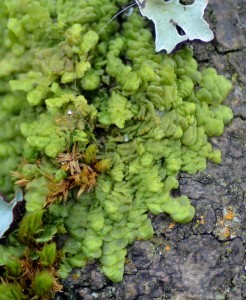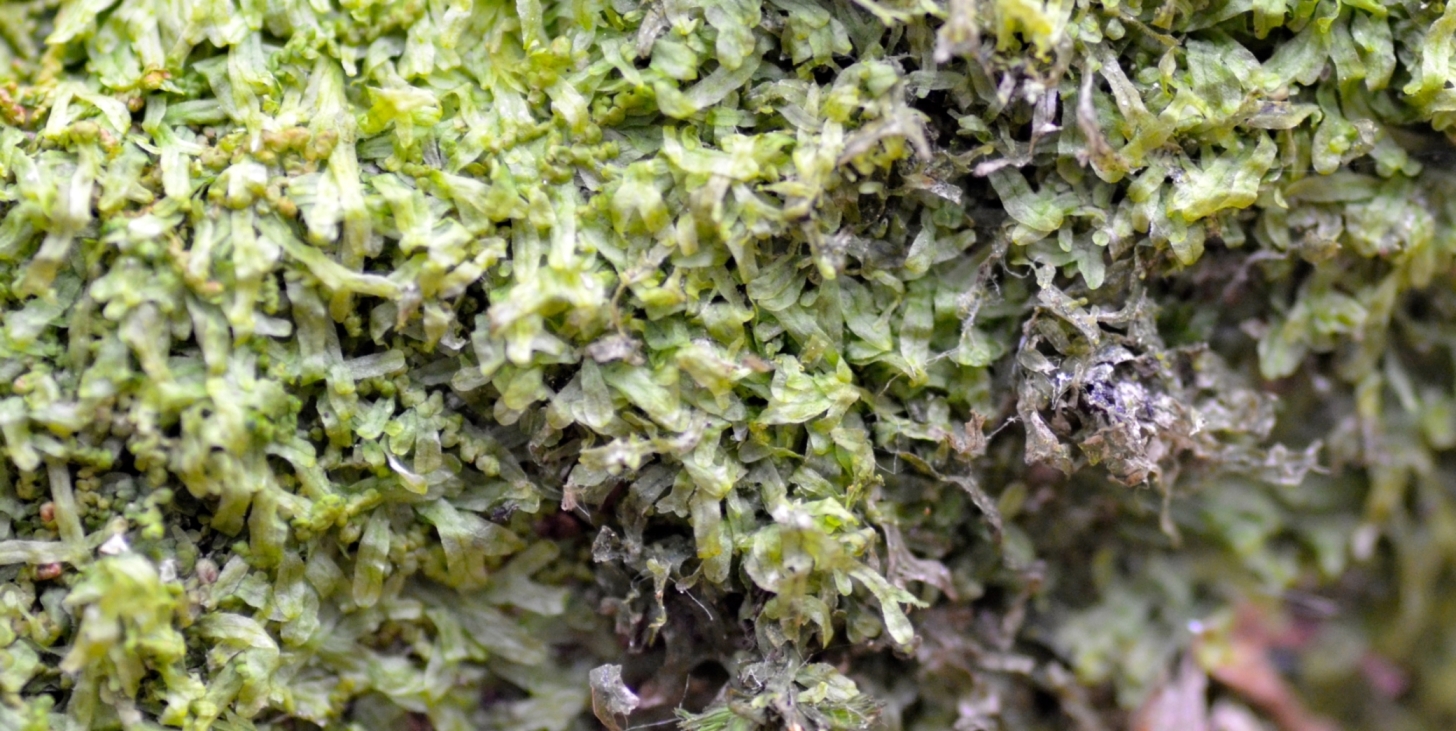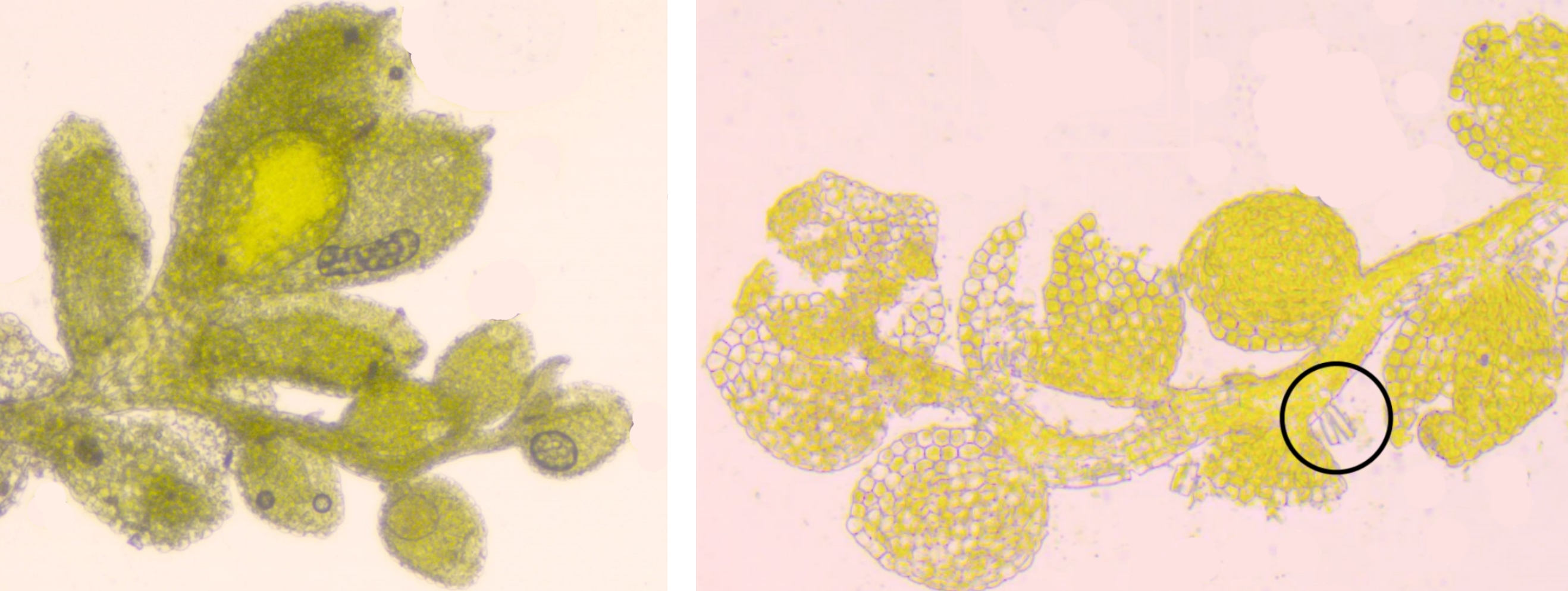2. Epiphytic Liverworts
This is the third in a series of posts exploring the mosses and liverworts (bryophytes) of the Whiteknights campus. My first two posts introduced some common and not so common mosses of trees (epiphytes), and this post will address the liverworts to be found in association with these on campus. Liverworts are not very well represented in most parts of lowland England so one need not fear being overwhelmed by species.
Although grouped with mosses, liverworts are not very closely related, forming a separate phyllum in the plant kingdom (Marchantiophyta). They come in two kinds: leafy and thalloid. The leafy kind is differentiated into stem and leaves, the thalloid is not. Leafy liverworts look somewhat like mosses, while thalloid liverworts bear some resemblance to small versions of familiar seaweeds such as bladderwrack (Fucus vesiculosus), with their plate-like dichotomously branched growth form (or just a green mess). An interesting physiological character that will sometimes identify leafy liverworts (e.g. Lophocolea) as not being mosses is their smell: liverworts store food in often aromatic oilbodies, mosses in scentless starch grains (though they may smell generally earthy).
On campus there are two epiphytic thalloid liverwort species, Metzgeria furcata and M. violacea. These are small plants, the thallus being not much more than 1mm in width, but are easy to find as they grow in conspicuous dull green mats pressed close against the bark. The ends of the shoots are dichotomously branched. In M. furcata the branches are wide and their ends rounded, while the branches of M. violacea are constricted. The fork-like branches of the latter species bear large clusters of light green gemmae (see my last post on gemmae) on their tips. M. furcata can be found in most places on campus and on all kinds of tree; M. violacea would appear to be a little less common. I have not succeeded in finding the similar M. consanguinea on campus but it may well be about.
The thallus of a Metzgeria species has a conspicuous stem-like axis along its length, and the wing-like green part is one cell thick like the leaves of leafy bryophytes. This observation lends some credence to the grouping of Metzgeria with the leafy liverworts (in class Jungermanniopsida) to which we now turn. The much larger and tough-looking thalloid liverworts such as Marchantia (class Marchantiopsida) we shall meet later.

Comparison of the leaves of liverwort (left) and moss (right). Left: the notched leaves of Lophocolea bidentata. Right: half of the simple leaf of Funaria hygrometrica (x50) showing the nerve and pointed tip. Images by D. Morris
Leafy liverworts are similar to mosses in that the plant is differentiated into stem and leaves. However, liverworts usually grow in more or less prostrate mats and the leaves are even simpler than those of mosses, for they lack the strengthening midrib (nerve or costa) present in most mosses. The leaves of mosses are never lobed as they often are in liverworts, and, although it is not obvious, this is the case in Frullania dilatata, probably the most frequent epiphytic leafy liverwort on campus.

The scaly appearance and dark colouring are characteristic of Frullania dilatata. You may be able to make out larger flap-like leaves terminating some shoots (perianths). Image by D. Morris
F. dilatata is a medium sized liverwort forming dark green or reddy-brown scaly-looking patches on bark. Under a hand lens one can see that the scaly appearance is due to the arrangement of the leaves: each leaf strongly overlaps the rear part of the next leaf, so that the whole shoot resembles a shingled roof. This kind of leaf arrangement is termed incubous (not incubus!). The arrangement in which successive leaves overlap the other way around is termed sucubous.

Ventral surface of Frullania dilatata (x20) showing (a) the part of a leaf visible from above, (b) the smaller ventral lobe of same leaf and (circled) an underleaf, in this species deeply lobed. Image by D. Morris
Laid on its back one sees that Frullania actually posseses a third row of smaller leaves (underleaves) and that each of the larger leaves possess tiny lobes. The smaller of these two lobes is tucked under the larger and from beneath appears to form a further row of underleaves. If you don’t believe that these are lobes of one leaf and not separate leaves then try to dissect a shoot: you will find that the two lobes have the same point of attachment.
The only species on campus with which F. dilatata might be confused is Radula complanata. This species is usually a pale bluey-grey green colour and grows in smaller patches more closely pressed against the bark. The shoots are wide, with more rectangular leaves than F. dilatata and the branches rather short.

Radula complanata growing closely adpressed to bark. Enlarging this image and looking closely, gemmae can be seen scattered along the margins of some leaves. Image by D. Morris
We now turn to the most interesting liverwort on campus. C. minutissma is apparently an Atlantic liverwort which has greatly expanded its range inland from around the coasts of southern Britain, presumably in response to climate change. Whiteknights is only the third locality in Berkshire known to me for Cololejeunea minutissima. I have seen it at Greenham Common, not far from where it was found in 2008. The first record of 1983 is also from near Newbury. This species is, however, so small (hence minutissima) that it could be easily overlooked (Berkshire also has few active bryoligists, so recent advances into the county may have gone unrecorded). You will find it in the clearing in the Wilderness growing on branches of a few oak trees on the edge nearest the grotto.
The indistinct C. minutissima looks very much like a smudge of green algae to the naked eye, but it is easy to identify under a lens. The leaves are rounded and distantly spaced along the fragile stems, which at intervals produce branches bearing the female sex organs. These are protected by leaves fused into a characteristic and very pretty five-pointed star (perianth). In comparison to the leaves these perianths are quite large objects and really jump out at one, so that a formerly anonymous green smudge suddenly becomes an uncommon liverwort under ones lens.
If your green smudge does not resolve itself into C. minutissima but appears to have stems and leaves then you are likely looking at Microlejeunea ulicina, a member of the same family. I have only found this liverwort on one oak tree, but confess to not having looked very hard for it. Nationally it is a commoner liverwort than C. minutissima and tends to grow in small quantity often amongst mosses. C. minutissima on the other hand will grow in quite extensive pure colonies. M. ulicina lacks the star-like perianths of C. minutissima, and its leaves are ovate compared with the round leaves of C. minutissima. Forked underleaves are also present on M. ulicina, but these can only be seen with a high-power microscope.







Lovely introduction to this neglected group and super images! Dr M
One of the “stone circle” near the Grotto seems to have Metzgeria temperata (syn consanguinea) growing through a mat of Lophocolea and other bryophytes. The distribution of gemmae is more lateral than apical and M violacea (syn fruticulosa) isn’t supposed to grow on rock so it might be worth a look.